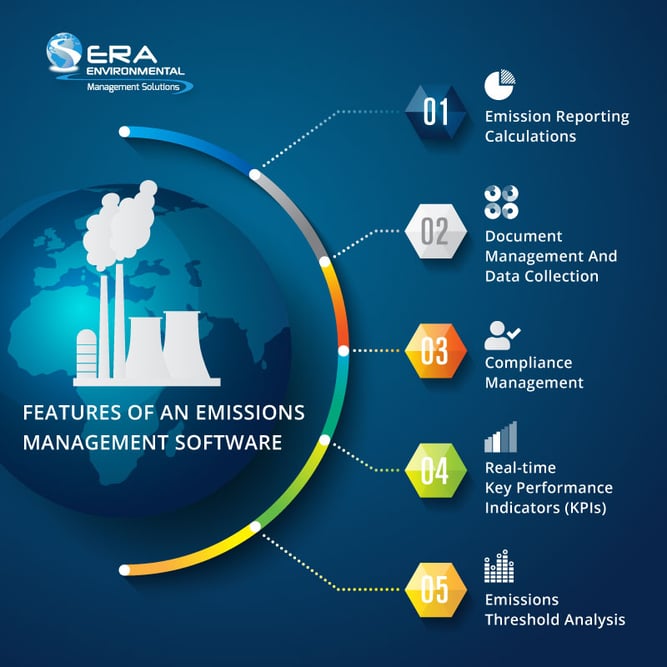Updated March 2025
Imagine having Emissions Management Software that matches your chemicals, practices, and equipment. Having software would make air emission tracking, environmental management, and greenhouse gas reporting a painless process for your facility. Too often, businesses believe that air emissions management can be done with just any generic database program. While an already built and tested model is required, it must be configurable to put you in the driver’s seat of your specific emission management process.
This article will help you understand:
- How your facility can formulate an air management strategy.
- The definition and features of Emission Management Software.
- Why configurable software is the best option for environmental management.
Managing Air Quality from Industry Air Emissions
The first step is to address how your organization will be formulating its air management strategy. Managing air quality involves considering your business operations’ environmental, engineering, and economic factors and using them to address emissions accurately. Examples of this process are looking at all your SDSs to determine the chemicals you use, checking equipment as potential sources for emissions, and checking the allocation of funds for waste minimization practices that help control and limit your emissions.
After evaluating factors such as these, you can set up your emission control strategy. To meet your facility’s determined emission reduction goals, the EPA recommends the following steps for emission monitoring, reduction, and management:
- Determine Priority Pollutants and Criteria Air Pollutants in your facility. Determining the priority pollutants present in your facility is a good step to check which chemicals and products are subject to regulations.
- Identify measures to control sources of pollution. The pollution sources vary, including combustion processes, VOC emissions from paint processes, and tank emissions. Evaluating the sources is the best way to devise plans to reduce them from the source either by process modification or equipment upgrade.
- Develop control strategies and plans that factor in the control measures. There are various emission control strategies, including adding detectors and monitors to your emission sources to stay on top of your facility’s emissions.
- Use tailored emissions management software. Currently, many systems can help you manage all your emissions and house all the regulations related to the chemicals you use at your facility. This can help you specifically manage and report your emissions.
What is an Emission Management Software?
An emission management system is a system for managing air emissions by tracking and calculating them for reporting. Its primary function is to help your facility carefully track emissions to avoid exceeding federal emissions thresholds. Ideally, this software would be able to track and calculate emissions at a chemical/CAS level. Also, the system should be equipped with the regulatory flags and reporting formats for submission to maximize and streamline your reporting process.
What are the Features of an Emissions Software?
Features of these systems range from simply being document storage platforms to robust systems that can carry out calculations for environmental reports. Emissions software has different capabilities that the software provider defines, but the baseline of these capabilities is:
- Emission reporting and documentation.
- Compliance management.
- Emissions threshold analysis, regulatory updates, and KPIs.

Emission reporting and documentation is an important feature. Some software solutions also have reminder systems for reporting deadlines and alerts when your facility is approaching a defined threshold. Document management and data collection are crucial features of emissions software. This allows a centralized platform where all the information on machinery and equipment is carefully tracked. In the context of software, the right solution allows seamless data collection and compilation.
Compliance management is the continuous process of assessing your facility practices and systems to ensure that they follow set regulations for your industry. Part of this process is constantly conducting audits and reporting on emissions frequently in programs such as TRI or Tier II. Most systems that do this need to have readily available regulatory data.
Emissions threshold analysis is essential in tracking your progress as a facility. Having comprehensive and real-time Key Performance Indicators (KPIs) shows your executives and other internal stakeholders how well you are managing your emissions. Ensure that your chosen software solution has built-in regulatory information that is frequently updated. ERA’s Emissions Management Software has a built-in Master Chemical List (MCL) that is frequently updated with the latest regulatory information.
Choosing the Right Emissions Software
When you are evaluating how suitable Environmental Management System (EMS) software is for your business, it’s important to remember that sometimes the features you don’t see upfront can make all the difference. This includes the kind of ongoing support that comes bundled with whatever third-party software supplier you use.
Things like technical support, regulatory support, and flexibility can often be overlooked but make a big difference after the purchase has been made. All of those components that you typically overlook during your initial evaluation might just be what sells you on a system later on.
Technical Support
Having someone available to answer your questions about technical setups or equipment troubleshooting could prove to be a lifesaving feature.
The last thing you need is a computer glitch getting in the way of a compliance reporting deadline.
Go beyond having an automated system to help you reset your password - seek technical support to help you handle difficult situations. When your business upgrades to a whole new hardware system and you need to reconfigure your setups, will the company you’re with help you work through it, or will it charge you extra for further implementation?
Also, look for a technical assistance program that doesn’t just transfer you to a call center that knows nothing about your business or compliance needs.
When you have a technical support issue as an EH&S specialist, you need assistance from someone who knows all the ins and outs of regulatory compliance and understands why your issue affects your entire facility.
Regulatory Support
Environmental professionals spend hours every week double-checking and researching regulatory updates and reviewing permit conditions. That’s because the smallest change in how an emission must be reported or a changed deadline can cause havoc for your regulatory compliance if you don’t see it coming.
So expect more from your software provider, and don’t just settle for technical assistance. Exceptional support includes regulatory compliance assistance, keeping you in the know about upcoming changes, new regulations, and advanced voluntary reporting options.
Having regulatory compliance support differentiates true environmental software from basic database applications. Paying for a software platform that does nothing more than hold your data doesn’t make any sense, and if your provider doesn’t understand how environmental compliance works, how can you expect them to build an application that makes your job easier?
That’s the reason why ERA’s support team always puts you in touch with one of our environmental scientists. Regulatory compliance support is simply essential to any EMS software you choose. Otherwise, it just changes the way you do things when you want something that improves them.
Flexible for Your Needs
ERA Environmental recently chatted with some EH&S professionals about why they were (or were not) using EMS software for their compliance needs. One environmental manager summed up the main obstacles related to third-party software pretty well:
“When there are small changes in the company’s strategy, there are also changes in the types of information that we’re using. Therefore, we would have to make some changes in our database or software, paying quite high amounts for a 3rd party developer (it’s like with SAP, a small change = a big amount).”
These concerns are valid, but they don’t paint the whole picture. The fact of the matter is that some EMS software solutions do offer the same flexibility as an internal or custom system, can be agile enough to keep up with your business’ timeline (and not just the developer’s timeline), and don’t have to cost anything for these types of customization.
Those downsides listed in the EH&S specialist’s statement are inherent to database applications, not true environmental solutions. A static database is inherently rigid and nearly impossible to change without restructuring the entire program.
An EMS is meant to be ever-evolving, so EMS software should rapidly adjust to any changes you want to make. That could mean you need to start using it to track a new permit condition or want to start monitoring your toluene from specific processes when you weren’t before. Your software provider should already supply the ability to make the changes you want on the fly and help you to implement those changes.
Why Is a Configurable Solution Always Best?
Having something configurable eliminates the problems of hardcoded generic models and helps you achieve more accurate results. Having a solid structure and tested backbone for the software is vital, but it should not be so hardcoded that it denies you the ability to access features specific to your facility. So, why would you settle for a non-configurable EMS solution for your business instead of investing in configurable air emissions software?
Businesses often fall into the trap of using spreadsheets, which industry experts already know don’t work. Opting for spreadsheets means maintaining your formulas, researching and loading your own regulatory/chemical information, and hours manually entering data. A single typo could invalidate all of your calculations. For example, entering the percentage of toluene as 30% instead of 3% for a chemical can offset emission calculations significantly. As your datasets grow, the spreadsheet method becomes unsustainable.
Hardcoded generic business resource software products can be just as ineffectual. In some cases, the software is simply a storehouse for your data, and you’ll still have to do all the data entry and calculations for yourself. Even those EMS solutions that offer calculation features can only perform overall calculations and may not factor in the details and nuance of your facility. Anything outside the box the developer thinks you need is impossible or requires you to purchase “add-on” toolsets. An ideal software should bypass these programming limitations. Having a configurable UI allows you to log data for your specific practices.
Your sites’ environmental reporting needs are different than anyone else’s. You have different air permits and permit limits, use other materials, and have different air emission and operating limits depending on your location and what you produce. That is why you need air emissions software that shows menus and metrics that match your facility and is complete with all the reports you must submit internally and to regulatory agencies.
The Right Environmental Management System for Your Needs
You save time by eliminating the inefficiencies in your reporting process, and the investment into configurable air emissions software can be returned in just a few months. Manufacturers that have switched to configurable air emissions software are saving money. When your business is ready to upgrade to air emissions software, ensure you aren’t settling for the overly generic and ineffective.
Pick an environmental management solution tailored to get you the best results. ERA’s Air Emissions Software has all these capabilities: built-in calculation methodologies and formulas, AP-42 library, and many more capabilities that are well developed and vetted but still configurable to your facility’s specific needs.
Experience how configurable air emissions software can make your environmental responsibilities more manageable and cost-effective by booking a complimentary consultation call with a project analyst at ERA.
This Blog was Co-Authored By:



October 27, 2011
Comments